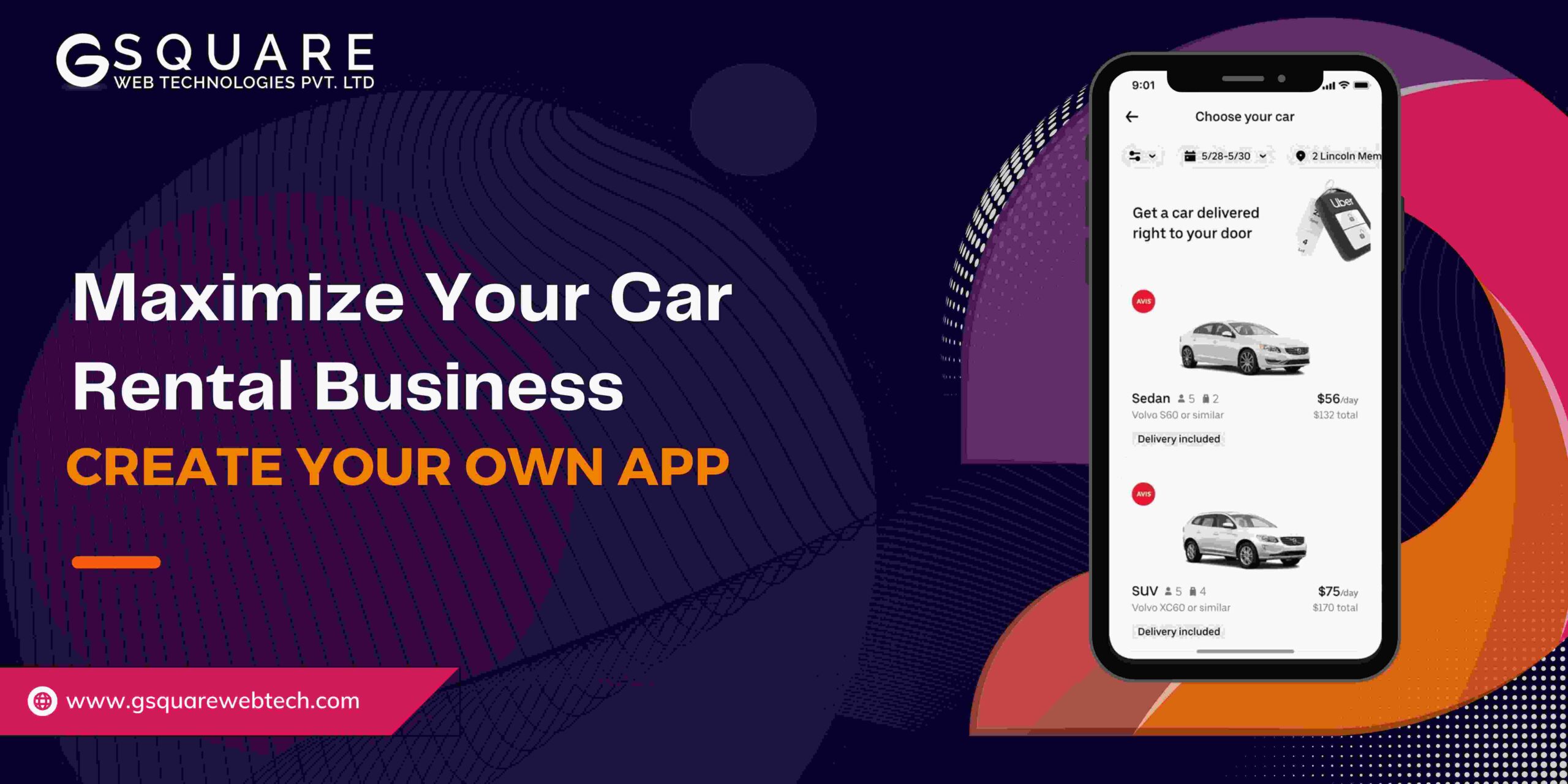
Maximize Your Car Rental Business: Create Your Own App
There are many ways to travel. Plenty of options are now available for travel lovers. Whether you have to travel for your business trips or you want to have some outdoor fun, you need a comfortable vehicle to reach your destination quickly, safely, and within your budget. These all conditions can be fulfilled by rental cars.
That’s why the rental car business is in trend. If you are a business owner looking to upscale your business this article is for you. In this guide, we are going to explain the process of building a car rental app to capture the US market. These details will also include information about the process of renting a car and the recent trends in the market.
Overview of Car Rental Industry Market Trends
Before kickstarting any business or initiating the process of developing a business app, we should go through the data first. The data-driven decisions are necessary to ensure the success of any business. If we talk about the data on car rental companies between 2019 and 2022, the car rental market in the United States saw significant growth.
It increased from 32.6 billion U.S. dollars in 2019 to 41.7 billion dollars in 2022. Though there was a notable decline in the car rental market size in 2020 due to the COVID-19 breakout the market size then increased dramatically in 2021 with the lift-up of these restrictions and the growth continued into 2022.
How to Leverage the Trends in Car Rental App?
To leverage the trend in car rental apps effectively you have to start with thorough market research. You have to analyze market demands and identify your target audience’s needs and preferences. If you stay updated with technological advancements like AI and IoT, it will help you with enhancing the overall user experience.
Whenever you start to develop a car renting app be assured to prioritize a user-friendly interface with a user-friendly design. Also, ensure that the booking process is seamless and features real-time availability.
To make it more user-friendly and lead generator add features like transparent pricing and multiple payment options. To speed up the transaction across the app, a mobile wallet should be integrated.
Additionally, if you want to stand out in the competitive market consider offering unique features like GPS integration for real-time tracking and management solutions for efficient vehicle scheduling and maintenance.
You can also consider some of the customization options that can meet the specific needs of your target audience. Remember, to leverage the car rental app trend to its full potential you have to stay updated with the market dynamics and embrace innovations.
Benefits of a Car Rental App
Having a car rental business without an app will hinder the development of your customer base and ultimately lead to huge revenue loss. Here’s a list of benefits of having a car rental app:
| Category | Description |
|---|---|
| Convenience | Car rental apps offer the ultimate convenience by allowing users to book a rental vehicle from the comfort of their own devices. |
| Accessibility | Car rental apps typically feature a wide selection of vehicles, ranging from compact cars to SUVs and luxury cars. |
| Cost-Efficiency | Car rental apps often provide competitive pricing, discounts, and special offers. Users can easily compare rates between different rental companies and make informed choices, potentially saving money in the process. |
| Transparency | Car rental apps offer comprehensive information about rental terms, insurance options, fees, and fuel policies. This transparency helps users make well-informed decisions and avoids unexpected costs or surprises during the rental process. |
| User Reviews | Most car rental apps allow users to read and leave reviews about their rental experiences. This feature enables potential renters to gauge the reputation of the rental company and the condition of the vehicles, promoting accountability in the industry. |
| GPS Integration | Many car rental apps have built-in GPS features that assist users in navigation, locating their rental vehicle, and finding nearby gas stations, restaurants, or tourist attractions. This added functionality enhances the overall travel experience. |
| 24/7 Access | Car rental apps provide users with the flexibility to book a rental car at any time, day or night. This is especially valuable for travelers arriving on late-night flights or those in need of last-minute transportation. |
| Paperless Transactions | Digital contracts, receipts, and documentation reduce the environmental impact of renting a car. Users can conveniently access all necessary information on their devices, reducing the need for physical paperwork. |
| Notifications and Alerts | Car rental apps send users notifications about their bookings, including confirmation, pickup and drop-off details, and reminders for returning the vehicle on time. This feature keeps users organized and ensures a smooth rental process. |
| Customer Support | Many car rental apps offer customer support through various channels, such as chat, email, or phone. This accessible support system allows users to quickly address any issues, seek assistance, or obtain answers to their questions. |
Suggested Read: How to Quickly Start an Online Store Step-by-Step Guide
How does a Car Rental App Work?
The working of a car rental app is as follows:
- Step 1: Car rental app allows a passenger to request a cab. They can customize it to their personal preferences and choose a scheduled trip or an instant book.
- Step 2: The internal programming of the app matches passengers with appropriate cabs. On the other side, the owner receives a request and then decides whether to accept or reject it.
- Step 3: After that the Car rental app allows the passenger to calculate rent cost. Passengers can also track rent progress in real time.
- Step 4: Platforms charge clients after the ride. The total cost of the trip depends on several factors such as location, distance, demand, peak hours, vehicle type, and others.
- Step 5: Once the trip is finished, passengers can leave feedback for the service. These rating systems encourage car rental companies to provide a better service.
Key Features of a Car Rental App
A car rental app is designed to facilitate the process of renting a car at passengers’ convenience. It allows users to find, book, and manage rental vehicles. Some of the key features commonly found in a car rental app are as follows:

1. User Registration and Profile Management
The app allows passengers to register and log in for account creation. It also manages the profile and updates personal information and payment details. Sometimes social login options are also given for user convenience.
2. Car Search and Listings
To allow passengers to search cars according to their needs search bar with filters is also implemented to let them find cars based on location, date, time, and vehicle type. To make it more convenient detailed car listings with images, descriptions, and pricing information are also uploaded on the app.
3. Booking and Reservation
Another feature of the car-renting app is Booking & Reservation. This feature helps passengers to rent a car for a specific date and time. These features may include features like GPS, insurance, child seats, etc. By using it passengers can confirm the rental reservation with a booking summary and payment options.
4. Payment Gateway
This feature is for secure payment processing for rental fees. Multiple payment methods, including credit cards, debit cards, and digital wallets can be integrated with payment gateways for transactions.
5. Availability and Scheduling
This feature allows one to track the real-time availability of rental cars. It can include a calendar view for selecting pick-up and drop-off dates, notifications, and alerts for upcoming bookings.
6. Geolocation and Maps
This feature allows integration with maps and GPS for locating rental stations. Directions to the pick-up and drop-off points. Location-based search and recommendations.
7. Reviews and Ratings
Using it passengers can find user reviews and ratings for each car and rental agency. Comments and feedback to help users make informed decisions.
8. Booking History and Receipts
This allows access to a booking history with past and upcoming reservations. Moreover, generates digital receipts and invoices for completed bookings.
9. Vehicle Information
This comes with a specific tap that carries detailed information about each car, including make, model, year, mileage, and features. It also carries photos and videos of the vehicles.
10. Alerts and Notifications
Just like socials car rental apps can also provide with option of push notifications for booking confirmation, reminders, and updates. Alerts for special offers, discounts, and promotions can also be generated using this option.
Steps to Develop a Car Rental App
The process of developing a car rental app is a complex project that requires careful planning and execution. Let’s learn the steps involved in the development of a car rental app:
1. Idea and Conceptualization
First of all, define the purpose and goals of your car rental app. Identify your target audience and their needs. Conduct market research to understand the competition and demand.
2. Business Model and Strategy
Choose a business model, such as a commission-based model or a subscription-based model. Plan your revenue streams, pricing strategy, and monetization options.
3. Technical Requirements
Determine the technology stack for the app, including the choice of platforms (iOS, Android), backend technologies, and databases.
4. Legal Considerations
Ensure that you meet all legal requirements and regulations for operating a car rental service in your target locations. Consider legal aspects of user data privacy, payment processing, and insurance.
5. Wireframing and Design
Create wireframes and mockups of the app’s user interface. Design the user experience (UX) and user interface (UI) for a visually appealing and user-friendly app.
6. Backend Development
Set up the server infrastructure and databases. Develop the backend logic for user authentication, vehicle listings, booking management, and payment processing.
7. Frontend Development
Develop the mobile app for both iOS and Android platforms using native or cross-platform development tools.
Implement user registration, search, booking, and payment features.
8. Integration with Third-party Services
Integrate mapping and geolocation services for finding rental stations and navigation. Integrate payment gateways for secure transactions. Integrate communication channels like email or push notifications.
9. User Authentication and Security
Implement user authentication and authorization. Ensure data security and encryption of sensitive information.
10. Search and Vehicle Listings
Develop a robust search engine with filters for users to find rental cars based on their preferences. Implement features for car listings, including images, descriptions, pricing, and availability.
11. Booking and Reservation System
Build a booking and reservation system with options to select pickup and drop-off locations, dates, and times. Implement a payment system for booking confirmation.
12. Rating and Review System
Create a rating and review system for users to leave feedback on their rental experience. Include features for rating cars and rental agencies.
13. Testing and Quality Assurance
Conduct thorough testing, including functional testing, usability testing, and security testing. Address and fix any bugs or issues.
14. Deployment
Deploy the app to the Apple App Store and Google Play Store. Ensure that the app meets platform-specific guidelines and requirements.
15. Marketing and Promotion
Develop a marketing strategy to promote the app, including social media, advertising, and partnerships. Utilize search engine optimization (SEO) techniques for better discoverability.
16. User Support and Maintenance
Provide customer support for users with questions or issues. Regularly update the app to fix bugs, improve performance, and add new features.
17. Monitoring and Analytics
Implement analytics tools to monitor user behavior and app performance. Use this data to make informed decisions and improvements.
Conclusion
In today’s diverse and competitive travel landscape, having a car rental business without a well-developed app is a missed opportunity. Car rental apps offer incredible convenience, accessibility, cost-efficiency, and transparency, enhancing the overall experience for both renters and rental agencies. If you are looking to build a car rental app feel free to reach our seasoned developers and ask your queries.
FAQs
1. What are the key benefits of having a car rental app?
Car rental apps offer convenience, accessibility, cost-efficiency, and transparency.
2. How does a car rental app work?
Car rental apps connect users with available vehicles, allowing them to book, track, and complete rentals. Users can customize their preferences, track trip progress, and leave feedback, while drivers can accept or reject trip requests.
3. What are the key features of a car rental app?
Key features include user registration, car search listings, booking, and reservation systems.
4. What are the critical steps in developing a car rental app?
The development process involves research, defining a business model, determining technical requirements, and designing, backend and frontend development.
5. How can I stay competitive in the car rental industry with my app?
To stay competitive you have to be updated with market dynamics, innovations, and unique features. Offering excellent customer support is the cherry on the cake. Regularly monitoring and analyzing user behavior and performance data is crucial for making informed decisions and improvements.






